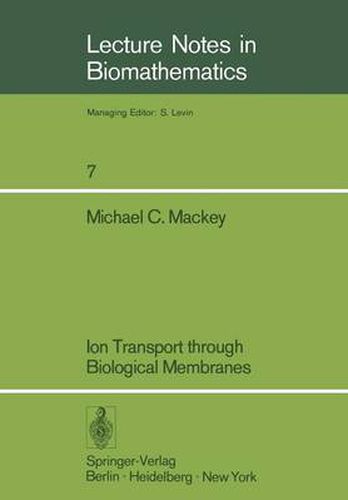Readings Newsletter
Become a Readings Member to make your shopping experience even easier.
Sign in or sign up for free!
You’re not far away from qualifying for FREE standard shipping within Australia
You’ve qualified for FREE standard shipping within Australia
The cart is loading…






This title is printed to order. This book may have been self-published. If so, we cannot guarantee the quality of the content. In the main most books will have gone through the editing process however some may not. We therefore suggest that you be aware of this before ordering this book. If in doubt check either the author or publisher’s details as we are unable to accept any returns unless they are faulty. Please contact us if you have any questions.
This book illustrates some of the ways physics and mathematics have been, and are being, used to elucidate the underlying mechan isms of passive ion movement through biological membranes in general, and the membranes of excltable cells in particular. I have made no effort to be comprehensive in my introduction of biological material and the reader interested in a brief account of single cell electro physlology from a physically-oriented biologists viewpoint will find the chapters by Woodbury (1965) an excellent introduction. Part I is introductory in nature, exploring the basic electrical properties of inexcitable and excitable cell plasma membranes. Cable theory is utilized to illustrate the function of the non-decrementing action potential as a signaling mechanism for the long range trans mission of information in the nervous system, and to gain some in sight into the gross behaviour of neurons. The detailed analysis of Hodgkin and Huxley on the squid giant axon membrane ionic conductance properties is reviewed briefly, and some facets of membrane behaviour that have been revealed since the appearance of their work are dis cussed. Part II examines the foundations of electrodiffusion theory, and the use of that theory in trying to develop quantitative expla nationsof the observed membrane properties of excitable cells, in particular the squid giant axon. In addition, an ad hoc formulation of electrodiffusion theory including active transport is presented to illustrate the qualitative nature of cellular homeostasis with respect to intracellular ionic concentrations and membrane potential, and cellular responses to prolonged stimUlation.
$9.00 standard shipping within Australia
FREE standard shipping within Australia for orders over $100.00
Express & International shipping calculated at checkout
This title is printed to order. This book may have been self-published. If so, we cannot guarantee the quality of the content. In the main most books will have gone through the editing process however some may not. We therefore suggest that you be aware of this before ordering this book. If in doubt check either the author or publisher’s details as we are unable to accept any returns unless they are faulty. Please contact us if you have any questions.
This book illustrates some of the ways physics and mathematics have been, and are being, used to elucidate the underlying mechan isms of passive ion movement through biological membranes in general, and the membranes of excltable cells in particular. I have made no effort to be comprehensive in my introduction of biological material and the reader interested in a brief account of single cell electro physlology from a physically-oriented biologists viewpoint will find the chapters by Woodbury (1965) an excellent introduction. Part I is introductory in nature, exploring the basic electrical properties of inexcitable and excitable cell plasma membranes. Cable theory is utilized to illustrate the function of the non-decrementing action potential as a signaling mechanism for the long range trans mission of information in the nervous system, and to gain some in sight into the gross behaviour of neurons. The detailed analysis of Hodgkin and Huxley on the squid giant axon membrane ionic conductance properties is reviewed briefly, and some facets of membrane behaviour that have been revealed since the appearance of their work are dis cussed. Part II examines the foundations of electrodiffusion theory, and the use of that theory in trying to develop quantitative expla nationsof the observed membrane properties of excitable cells, in particular the squid giant axon. In addition, an ad hoc formulation of electrodiffusion theory including active transport is presented to illustrate the qualitative nature of cellular homeostasis with respect to intracellular ionic concentrations and membrane potential, and cellular responses to prolonged stimUlation.